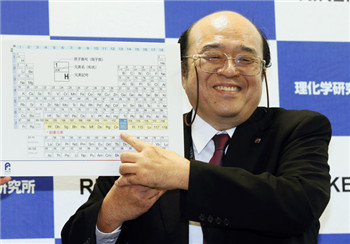
Since the 19th century, European and American discoveries have monopolized the naming of elements on the periodic table. It is evident in entries like francium, germanium, scandium, polonium, europium, californium, berkelium and americium.
自19世纪以来,欧洲和美国的发现垄断了对周期表中元素的命名。这一点在钫、锗、钪、钋、铕、锎、锫、镅等元素的拉丁名上颇为明显。
But now, for the first time, researchers in Asia will make an addition to chemistry’s most fundamental catalog.
但现在,亚洲的研究人员将首次在化学领域最基本的目录上增加一个条目。
Scientists from the Riken institute in Japan will bestow an official name on Element 113, currently known by the placeholder name ununtrium, the International Union of Pure and Applied Chemistry announced last week.
国际纯粹与应用化学联合会(International Union of Pure and Applied Chemistry)上周宣布,日本理化学研究所(Riken)的科学家将拥有给第113号元素正式命名的权利。该元素目前暂被称为ununtrium。
The organization said that studies published by the Japanese scientists from 2004 to 2012 give the team the strongest claim to having discovered the element. The declaration comes more than 12 years after the Japanese team first attempted to synthesize the superheavy element, by firing beams of zinc at a thin bismuth film.
化学联合会称,这些日本科学家在2004到2012年间发表的研究论文,让该团队有最为充分的理由宣称是他们发现了该元素。这一认可距日本团队首次尝试合成这一超重元素已过去了逾12年。他们做法是朝一层薄薄的铋膜发射锌束。
Led by Kosuke Morita, the group began to bombard bismuth atoms in a particle accelerator at 10 percent the speed of light in 2003. A year later, they successfully fused two atomic nuclei from these elements, creating their first nucleus of Element 113, but it decayed in less than a thousandth of a second. In 2005, the team produced Element 113 in a second event, but the chemistry union did not consider the demonstration strong enough to denote a discovery.
2003年,该团队在森田浩介(Kosuke Morita)的带领下,开始在粒子加速器中以10%的光速轰击铋原子。一年后,他们成功地让两个元素的原子核聚变,创造出了他们的首个113号元素原子核,但过了不到千分之一秒,它就衰变了。2005年,该团队第二次得到了第113号元素,但化学联合会认为并不足以证明发现了新元素。
“For over seven years, we continued to search for data conclusively identifying Element 113, but we just never saw another event,” Dr. Morita said in a statement. “I was not prepared to give up, however, as I believed that one day, if we persevered, luck would fall upon us again.”
“在七年多时间里,我们持续寻找能不容置疑地证明第113号元素的数据,但再未成功过,”森田浩介在声明中说。“但我没准备放弃,因为我相信,如果坚持不懈,总有一天好运会降临在我们身上。”
In 2012, the team finally produced strong evidence that they had synthesized Element 113. Over the course of those nine years, the beam was active for 553 days and launched more than 130 quintillion zinc atoms, according to Nature.
在2012年,该团队终于得出了有力的证据,表明他们合成了第113号元素。《自然》杂志(Nature)称,这九年里,锌束活跃了553天,发射的锌原子数超过1.3乘以10的20次方。
The chemistry union, along with the International Union of Pure and Applied Physics, granted the Riken researchers naming rights to Element 113 over a joint Russia-United States team that had also claimed to discover the element.
化学联合会和国际纯粹与应用物理学联合会(International Union of Pure and Applied Physics)共同将第113号元素的命名权授予了理化学研究所的研究人员,而一支俄美联合团队抱憾。后者也声称发现了该元素。
The chemistry union’s decisions are detailed in two reports to appear in the journal Pure and Applied Chemistry. In addition to Element 113, Elements 115, 117 and 118 will also receive official names. Teams from Russia and the United States discovered those elements.
《纯粹与应用化学》期刊(Pure and Applied Chemistry)上发表的两份报告,详细解释了化学联合会的决定。除第113号元素外,第115号、117号和118号元素也将被正式命名。这些元素由俄罗斯和美国的团队分别发现。
With their discovery, the bottom row of the periodic table will be complete. Elements are numbered by the protons they have in their nucleus, and Elements 114 (flerovium) and 116 (livermorium) had previously been confirmed and named.
有了这些发现,元素周期表最下面一行将被填满。元素的序号是根据其原子核内所含的质子数决定的。第114号元素鈇(flerovium)和116号元素鉝(livermorium)此前已得到证实并完成了命名。
Dr. Morita has not yet announced what he intends to name Element 113, but according to a 2004 article in The Japan Times when the team first published its results, one likely contender may be “japonium.”
森田浩介尚未宣布打算给第113号元素起什么名字,但从该团队于2004年首次发表研究结果的时候《日本时报》(The Japan Times)当年刊登的一篇文章来看,其中一个很可能中选的拉丁名是“japonium”。












